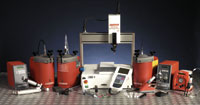
Posted to News on 22nd Nov 2010, 00:00
Answers on adhesive dispensing
We continue our series of articles on engineering adhesives and with the help of Henkel, manufacturer of Loctite brand products, we turn our attention to dispensing units.

Are there cost efficiencies to be made by using dispensing equipment? Without a doubt - and the savings and benefits are not limited to cost. The use of application equipment can ensure that only the required amount of product is dispensed for each specific situation. This alone can mean that savings of up to 50 per cent - when compared to manual application - can be achieved. Other efficiencies revolve around the fact that more throughput can be achieved by employing automated dispensing. In many cases, dispensing equipment can apply a product to a joint at the rate of one unit every two seconds. Furthermore, the application of product is precise - thus cutting down on reworking. It's also worth mentioning that application equipment means a cleaner - and safer - working environment.
Presumably, there are standard, off the shelf, dispensing units, but can equipment be designed to meet specific purposes? Yes! Although most manufacturers offer a standard range that will fulfil many requirements, there will be tasks that necessitate a dispensing unit to be made for a specific application. Clearly, custom-built equipment is created to ensure the application is completed in the most effective way that is possible.
What are the factors that need to be considered regarding dispensing equipment? There are four fundamental issues - adhesive type and viscosity, dispense pattern, production targets and the degree to which automation can be incorporated into the manufacturing procedure. When it comes to adhesive types, it will be obvious that single part adhesives demand quite different requirements to dual component products that require mixing before or during application. Anaerobics - those adhesives that cure on metal surfaces when deprived of oxygen - call for equipment which, quite clearly, incorporates no metal. In addition, the adhesive must be dispensed from a container that allows the presence of some air.
Premature curing
To prevent premature curing, ultra-violet curing adhesives must be dispensed from a container and through tubing that restricts natural light.
When it comes to viscosity, the key factor is whether the adhesive is a liquid or paste. That will determine the type of equipment required.
The dispense pattern can embrace single and multiple spots, linear beads and the uniform coating of the inside of bores. For spots - where their size can be anything from 0.01ml upwards - metering the adhesive is crucial for effective application. In such cases, equipment that includes such a device is essential. At the other end of the size scale, products such as gasket sealants are most effectively dispensed by high-pressure pumps capable of 'tracing' around a specified profile. Such units are usually connected to an anthropomorphic or a Cartesian robot. Where the adhesive needs to be applied to the bore of a circular component - engine core plugs are one example - a rotaspray configuration can be utilised.
The final consideration involves production targets. The decision to employ automation will frequently be dictated by production volumes - the larger the throughput, the more justification there is for capital expenditure. That means the application equipment has to provide payback in terms of quality and financial returns.
Just how does dispensing equipment work? There are several different principles involved. Probably the most common involves pressure/time technology. This is a method of dispensing liquid materials using air pressure for a specific period of time to force the adhesive, sealant or gasketing material through a dispensing needle. Typically, a syringe or pressure pot is used as the reservoir for the liquid material.
Another involves peristaltic pumps - a technology that has been employed in hospitals to control blood or liquid flow, but which is also applied to adhesive dispensing. This is where rotating wheel pinches and releases a tube carrying adhesive from the reservoir to the dispensing nozzle. The speed at which the cam rotates can be adjusted and this, in turn, regulates the amount of adhesive. A foot or finger switch on the dispensing nozzle controls when the adhesive is applied.
This occasional Q&A series will continue with further questions and answers on key technologies. If you have any specific queries about adhesives, please direct them to [email protected] and we'll do our best to provide answers in future issues of the magazine.








